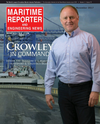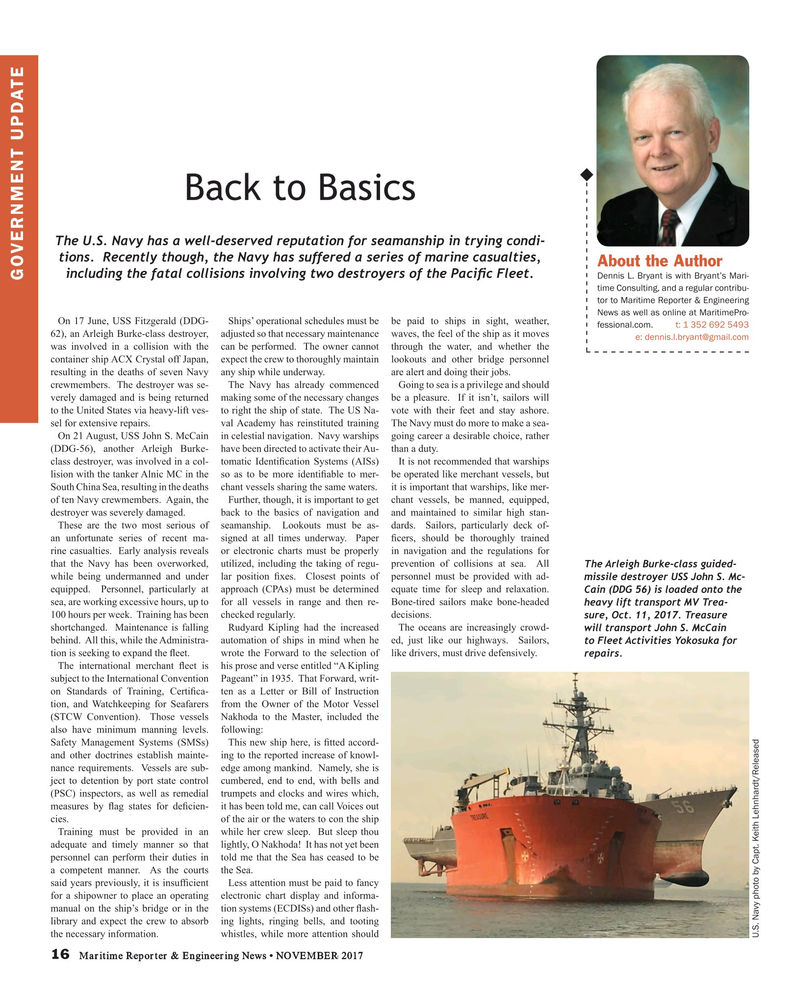
Page 16: of Maritime Reporter Magazine (November 2017)
The Workboat Edition
Read this page in Pdf, Flash or Html5 edition of November 2017 Maritime Reporter Magazine
Back to Basics
The U.S. Navy has a well-deserved reputation for seamanship in trying condi- tions. Recently though, the Navy has suffered a series of marine casualties,
About the Author including the fatal collisions involving two destroyers of the Paci? c Fleet.
Dennis L. Bryant is with Bryant’s Mari-
GOVERNMENT UPDATE time Consulting, and a regular contribu- tor to Maritime Reporter & Engineering
News as well as online at MaritimePro-
On 17 June, USS Fitzgerald (DDG- Ships’ operational schedules must be be paid to ships in sight, weather, fessional.com. t: 1 352 692 5493 62), an Arleigh Burke-class destroyer, adjusted so that necessary maintenance waves, the feel of the ship as it moves e: [email protected] was involved in a collision with the can be performed. The owner cannot through the water, and whether the container ship ACX Crystal off Japan, expect the crew to thoroughly maintain lookouts and other bridge personnel resulting in the deaths of seven Navy any ship while underway. are alert and doing their jobs. crewmembers. The destroyer was se- The Navy has already commenced Going to sea is a privilege and should verely damaged and is being returned making some of the necessary changes be a pleasure. If it isn’t, sailors will to the United States via heavy-lift ves- to right the ship of state. The US Na- vote with their feet and stay ashore. sel for extensive repairs. val Academy has reinstituted training The Navy must do more to make a sea-
On 21 August, USS John S. McCain in celestial navigation. Navy warships going career a desirable choice, rather (DDG-56), another Arleigh Burke- have been directed to activate their Au- than a duty.
class destroyer, was involved in a col- tomatic Identi? cation Systems (AISs) It is not recommended that warships lision with the tanker Alnic MC in the so as to be more identi? able to mer- be operated like merchant vessels, but
South China Sea, resulting in the deaths chant vessels sharing the same waters. it is important that warships, like mer- of ten Navy crewmembers. Again, the Further, though, it is important to get chant vessels, be manned, equipped, destroyer was severely damaged. back to the basics of navigation and and maintained to similar high stan-
These are the two most serious of seamanship. Lookouts must be as- dards. Sailors, particularly deck of- an unfortunate series of recent ma- signed at all times underway. Paper ? cers, should be thoroughly trained rine casualties. Early analysis reveals or electronic charts must be properly in navigation and the regulations for that the Navy has been overworked, utilized, including the taking of regu- prevention of collisions at sea. All The Arleigh Burke-class guided- while being undermanned and under lar position ? xes. Closest points of personnel must be provided with ad- missile destroyer USS John S. Mc- equipped. Personnel, particularly at approach (CPAs) must be determined equate time for sleep and relaxation. Cain (DDG 56) is loaded onto the sea, are working excessive hours, up to for all vessels in range and then re- Bone-tired sailors make bone-headed heavy lift transport MV Trea- 100 hours per week. Training has been checked regularly. decisions. sure, Oct. 11, 2017. Treasure shortchanged. Maintenance is falling Rudyard Kipling had the increased The oceans are increasingly crowd- will transport John S. McCain behind. All this, while the Administra- automation of ships in mind when he ed, just like our highways. Sailors, to Fleet Activities Yokosuka for tion is seeking to expand the ? eet. wrote the Forward to the selection of like drivers, must drive defensively. repairs.
The international merchant ? eet is his prose and verse entitled “A Kipling subject to the International Convention Pageant” in 1935. That Forward, writ- on Standards of Training, Certi? ca- ten as a Letter or Bill of Instruction tion, and Watchkeeping for Seafarers from the Owner of the Motor Vessel (STCW Convention). Those vessels Nakhoda to the Master, included the also have minimum manning levels. following:
Safety Management Systems (SMSs) This new ship here, is ? tted accord- and other doctrines establish mainte- ing to the reported increase of knowl- nance requirements. Vessels are sub- edge among mankind. Namely, she is ject to detention by port state control cumbered, end to end, with bells and (PSC) inspectors, as well as remedial trumpets and clocks and wires which, measures by ? ag states for de? cien- it has been told me, can call Voices out cies. of the air or the waters to con the ship
Training must be provided in an while her crew sleep. But sleep thou adequate and timely manner so that lightly, O Nakhoda! It has not yet been personnel can perform their duties in told me that the Sea has ceased to be a competent manner. As the courts the Sea.
said years previously, it is insuf? cient Less attention must be paid to fancy for a shipowner to place an operating electronic chart display and informa- manual on the ship’s bridge or in the tion systems (ECDISs) and other ? ash- library and expect the crew to absorb ing lights, ringing bells, and tooting the necessary information. whistles, while more attention should
U.S. Navy photo by Capt. Keith Lehnhardt/Released 16 Maritime Reporter & Engineering News • NOVEMBER 2017
MR #11 (10-17).indd 16 MR #11 (10-17).indd 16 11/5/2017 12:46:43 PM11/5/2017 12:46:43 PM

 15
15

 17
17
